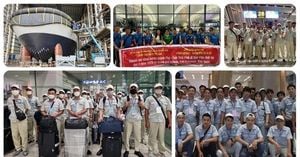A person accident at Kinshicho station on March 14, 2025, caused significant disruptions to train services across Tokyo’s rail network, affecting both the Sobu Rapid Line operated by JR East and the Tokyo Metro Tozai Line. The incident prompted immediate safety measures, leading to the temporary suspension of operations starting around 6:44 AM, but services resumed just over an hour later.
According to JR East, the operators of the Sobu Rapid Line, they announced around 8 AM the same day, "both the Sobu Rapid Line and the Chuo/Sobu Line resumed operation on all lines." The accident at Kinshicho station created chaos for morning commuters, many of whom rely on these lines to travel to work or school.
The situation was compounded on the Tokyo Metro Tozai Line, which was forced to halt its through services to the JR Chuo/Sobu Line Mitaka area due to the accident. Travelers were left scrambling for alternative routes, resulting in crowded platforms and lengthy delays. Information from the Public Transportation Open Data Center disclosed at 11:30 AM confirmed the restoration of normal services.
Incidents like this raise concerns about the overall safety and reliability of urban train systems. When disrupted, especially on weekday mornings, commuters find themselves facing stress and uncertainty. Public response to such events often reflects the anxiety felt by thousands of daily riders who depend on timely rail services.
Following the safety protocols, the operations team efficiently coordinated the resumption of services with minimal downtime. Yet, the eventual recovery of train operations does little to alleviate the frustrations of passengers who endure delays during their morning commute.
Japan’s highly regarded transportation system is known for its punctuality and efficiency. Therefore, disruptions, much like this accident, defy the standards travelers expect and can shake the overall perception of reliability. Commuters during the time reported experiences ranging from confusion to irritation, emphasizing the need for clear communication during emergencies.
Safety remains the utmost priority for railway authorities, leading to swift responses and rigorous post-incident evaluations. The JR East ensured they would treat the matter with the seriousness it deserves and conduct inquiries to understand precisely how the incident unfolded. Such analysis is part of efforts to prevent similar accidents from occurring again.
With overall operations having returned to normal, the focus now shifts to addressing any potential underlying issues related to safety procedures and accident prevention.
While commuters were understandably frustrated during the service disruptions stemming from the accident at Kinshicho station, the fast recovery speaks to Japan’s commitment to maintaining the integrity of its public transport systems. Local authorities and service providers continue to assure residents and daily commuters alike of their commitment to safety and efficiency.
Future conversations around urban transport safety protocols are likely to be informed by the events of March 14. The prompts to critically analyze the frameworks of response become imperative as community reliance on these systems grows.
Transportation services will remain central to urban life, driving discussions on improvements, efficiency, and safety measures particularly as cities continue to grow and evolve. While the incident may have triggered inconvenience, it undoubtedly shine light on the importance of readiness and effective response mechanisms within the extensive transport networks.



